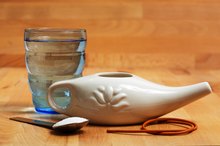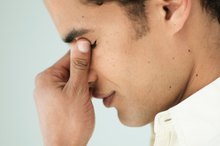What does fact checked mean?
At Healthfully, we strive to deliver objective content that is accurate and up-to-date. Our team periodically reviews articles in order to ensure content quality. The sources cited below consist of evidence from peer-reviewed journals, prominent medical organizations, academic associations, and government data.
The information contained on this site is for informational purposes only, and should not be used as a substitute for the advice of a professional health care provider. Please check with the appropriate physician regarding health questions and concerns. Although we strive to deliver accurate and up-to-date information, no guarantee to that effect is made.
How to Get Rid of Drainage in the Mornings
Mucus is an important substance that the nose and throat produce to lubricate nasal passages and trap and destroy foreign substances, such as allergens, bacteria and viruses. However, excess mucus may build up or thicken due to sinusitis, allergies or colds, becoming difficult to remove. Postnasal drip, or drainage, occurs when excess mucus runs down the back of the throat 1. Drainage may cause irritation in the throat, coughing or the urge to clear the throat to remove the mucus. Drainage is typically worse at night or in the morning, but you can usually prevent or relieve it easily.
If you are experiencing serious medical symptoms, seek emergency treatment immediately.
Use a humidifier to moisten the air in your bedroom overnight. Moisture aids in thinning mucus.
At Home Remedies for Clogged Sinus
Learn More
Sleep with your pillows propped up or use an elevated contour pillow to keep drainage from running down the back of your throat.
Hydrate yourself by drinking water and other fluids throughout the day. Proper hydration helps keep mucus thin so that it drains more easily.
Smelly Mucus in the Nose
Learn More
Use over-the-counter saline nasal spray or nasal irrigation (for example, a nasal rinse kit or neti pot) by following the package instructions. Spraying or rinsing nasal passages can help remove excess mucus or irritants that contribute to drainage. Medline Plus cautions you not to use saline nasal sprays more often than three days on and three days off unless directed by your doctor 2.
Take an over-the-counter expectorant (for example, guaifenesin) to thin mucus, or take an antihistamine or decongestant to reduce the amount of mucus produced. Your doctor can recommend an appropriate over-the-counter medication for you. Keep in mind that some over-the-counter antihistamines or decongestants have side effects, such as drowsiness, or may interact with other medications you are taking.
Contact your doctor if the drainage is yellow or green, especially if it is accompanied by sinus pain or fever. This coloring may signal a viral infection, such as a cold, or a bacterial infection. Antibiotics can treat bacterial infections only, and your doctor can prescribe or recommend other treatment options to relieve viral infection symptoms.
Related Articles
References
- WebMD: Postnasal Drip
- Medline Plus: Nasal discharge
- Mayo Clinic.com: Nasal congestion: When to see a doctor
- Sylvester DC, Karkos PD, Vaughan C, et al. Chronic cough, reflux, postnasal drip syndrome, and the otolaryngologist. Int J Otolaryngol. 2012;2012:564852. doi:10.1155/2012/564852
- American Academy of Otolaryngology–Head and Neck Surgery. Post-Nasal Drip.
- Mortuaire G, De gabory L, François M, et al. Rebound congestion and rhinitis medicamentosa: nasal decongestants in clinical practice. Critical review of the literature by a medical panel. Eur Ann Otorhinolaryngol Head Neck Dis. 2013;130(3):137-44. doi:10.1016/j.anorl.2012.09.005
Writer Bio
Kelly Smith has been writing professionally since 2010. She writes for various websites, specializing in health and literature. Smith is a certified pharmacy technician with more than five years of professional experience. She holds a Bachelor of Arts in English with a minor in multimedia communications from Regent University in Virginia Beach, Virginia.









